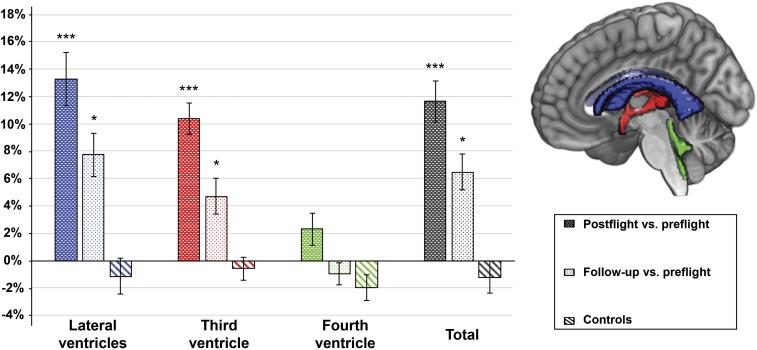
A few days back, my school-going cousin and I were having a discussion on ‘fun facts’. He soon mentioned to me about: Increase in Brain Mass of Astronauts after a Long Period of Time in Zero-G.
Now that’s surely something interesting, isn’t it? Let’s dig into a brief study related to it.

Living in constant downfall surely does strange things to the human mind and body. We are aware of the fact that spaceflights can inflict on the human body: There are data including loss of bone and muscle mass, distortion on eyeball size and if we want to talk about the effect of radiations on us, we’ll have to keep it for another article.
A study was published in JAMA Neurology, which mentions that long spaceflights have effects similar to changes seen with ageing in humans, the only difference is that in space the changes are faster and can be drastic.
While grey matter found in the brain achieve it’s development peak by our 20’s , the white matter doesn’t follow any such rule and continue to develop , making it prone to changes related to space travels in astronauts.
Very recently , researchers have claimed that the volume of white matter increases by 6% on prolonged period in the space. On average, in the astronauts’ lateral ventricles, specifically the spaces in the brain that contain CSF. However, the overall resulting volume is not be considered outside the range of healthy adults. There is a significant difference between preflight and post-flight values for all supratentorial ventricular structures, i.e., lateral ventricle (mean % change ± SE = 13.3 ± 1.9), third ventricle (mean % change ± SE = 10.4 ± 1.1), and the total ventricular volume (mean % change ± SE = 11.6 ± 1.5) (all P < 0.0001), with higher volumes at post-flight. These structures did not reach baseline levels, with still residual increases in volume for the lateral ventricle (mean % change ± SE = 7.7 ± 1.6; P = 0.0009), the third ventricle (mean % change ± SE = 4.7 ± 1.3; P = 0.0063), and the total ventricular volume (mean % change ± SE = 6.4 ± 1.3; P = 0.0008).

Additionally, there is an increase in velocity of CSF flow through the cerebral aqueduct too. The changes to white matter were mostly observed around pathways in the brain that process visual and spatial information, balance, vertical perception, and movement control. Spaceflight decreased fluid around the top of the brain and significantly increased fluid around the base of the brain, indicating that fluid distributions are altered by the upward shift of the brain within the skull.
A common question is that why this doesn’t happen when we are on earth? On Earth, the gravitational field creates a hydrostatic gradient, a pressure of the fluid that progressively increases from your head down to your feet while standing or sitting. This pressure gradient is not present in space.
Due to dysfunction of the water transport in microgravity, cerebral spinal fluid generated in the lateral and third ventricle migrate throughout the white matter and accumulates. This shots up an increase in combined brain and cerebrospinal fluid. The referred issues surely add on to the already known big concern about shifting of the brain upward within the skull during spaceflights and that the somatosensory cortex increase in the grey matter volume.
There have been researches and experiments trying to combat the effects of zero gravitation and preventing the building up of cerebrospinal fluid. A countermeasure experiment was set up by experimenting with the knowledge of artificial gravity and lowering body negative pressure.
As per reports, NASA developed a new technique that allows quantifying the fluid shifts occurring within astronaut’s brains using diffusion MRI scans. This tracks the movement of water molecules in the brain. But water molecule has motions limited by white matter fibre tracts in the brain, hence clear data wasn’t found on how actually the structure of white matter changes. But d-MRI did show alterations to the pituitary gland which governs the function of many other glands in the body.
Here one thing to keep in the notice is that all the problems concerning the astronauts won’t magically disappear when they return to planet home earth. A high percentage of explorers report bloodshot eyes and bad vision because of the mentioned pressure exerted by the fluids. The effects continue to haunt because of the increase in the volume of white matter in the brain. Post-flight evaluation has revealed swelling of the optic nerve, retinal haemorrhage and other ocular structural changes. This, with no doubt, raise concerns for long-duration interplanetary travels just, for example, our future mars missions.
There were a few encouraging signs too. Astronauts who had gone to frequent space missions (regardless of mission duration or cumulative days in space), experienced less drastic intracranial fluid movements. It might be a symbol that the physical body is capable of adapting to microgravity environments.
There’s no question all spaceflight teams want to avoid their astronauts having unsafe space experience which may harm their mind and body, especially the brain. There is no much study about this particular topic because of a lack of data. We’ve only launched a very small percentage of astronauts into space, and with such small experience we can’t really say much about it, neither start our research on the counter-methods.
Hopefully, as the goals to expand humanity’s presence in space starts to ramp up, the research and resources allocated to these studies will increase as well.
REFERENCES:
- https://www.theregister.com/2020/04/15/astronaut_brain_matter/#:~:text=Prolonged%20periods%20in%20space%20increases,workings%20of%20the%20human%20mind
- https://www.newscientist.com/article/2240405-long-space-flights-can-increase-the-volume-of-astronauts-brains/
- https://www.popsci.com/space-travel-brain-health/
- https://www.firstpost.com/tech/science/prolonged-travel-in-space-can-make-the-human-brain-bigger-change-its-functions-a-study-found-8266001.html
- https://pubmed.ncbi.nlm.nih.gov/31061119/
About the author
Shruti Mandal, a sophomore of IISER Kolkata is ongoing her BS-MS course, in the department of biological sciences. She likes to introduce herself as a – ‘Jack of all trades, master of none ‘. She is a regular writer at The Qrius Rhino and you can find all her blogs here.
It is remarkable, rather amusing idea
latinatubehd